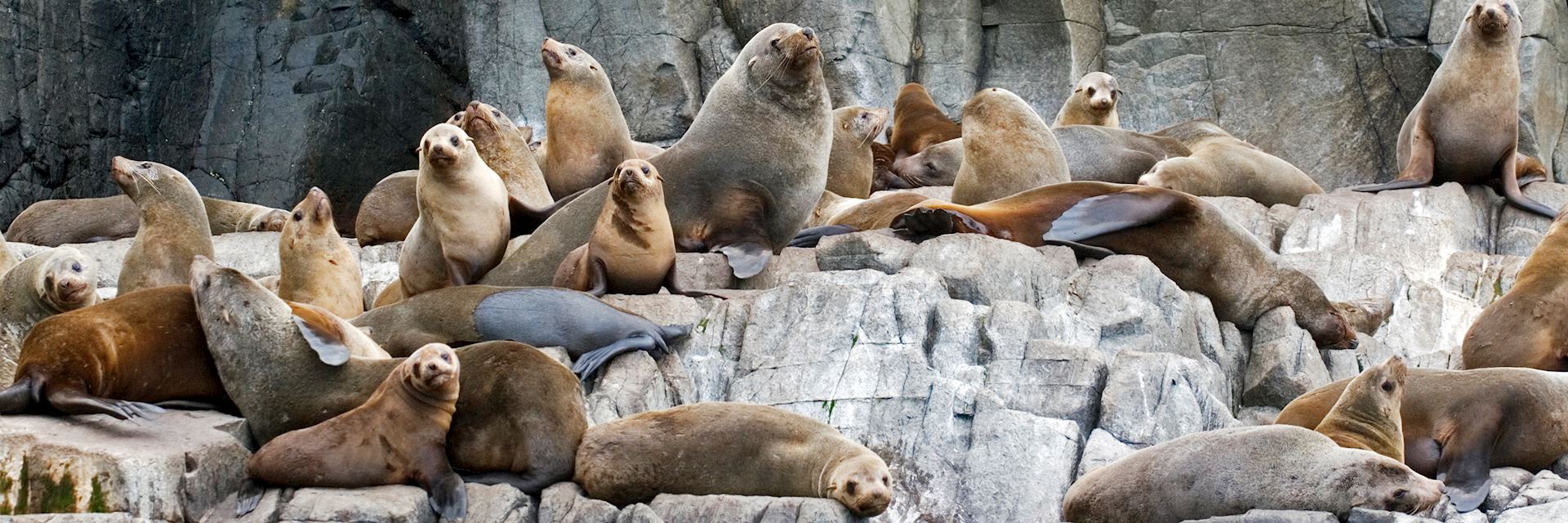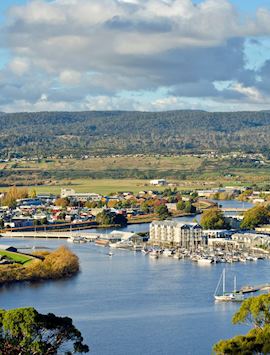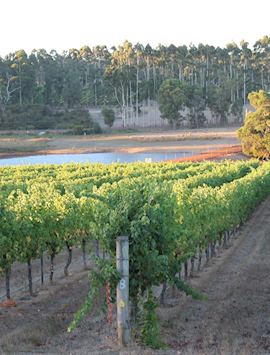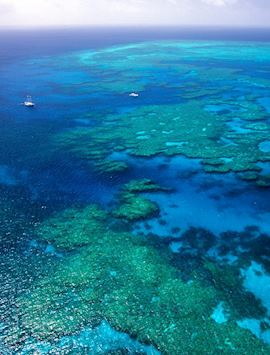By Australia expert Joshua
For such a small island, Tasmania packs in a wealth of opportunities to connect with wildlife. From the island’s namesake Tasmanian devils to fleet-footed wombats that can run as fast as Usain Bolt and pointy-snout bandicoots to big-beaked platypus, Tasmania is a place you can seek out the myriad animals that are only found in Australia.
Just off the coast of mainland Australia, Tasmania is also known for its rich birdlife. Twitchers can look for wrens, honey eaters, robins, raptors, and water fowl, to name just a few of the nearly 400 species of birds that you might see on the island.
Tasmania: wildlife & more

To me, what makes Tasmania stand out as one of the top places to experience wildlife in Australia isn’t just the wide variety of species found in a relatively small place but the island’s varied wild landscapes in which you encounter them. You’ll see a wide range of biomes, from the jagged peaks of Cradle Mountain to the rolling farmlands of Scottsdale, and the steep cliffs and sandy beaches of Bruny Island.
Each of the wildlife experiences that I recommend in Tasmania offers something different, whether you prefer exploring by yourself on multi-day treks, private wildlife tours designed to find the exact animals on your wish list or visiting animal sanctuaries to learn more about the protection of Tasmania’s unique species.
Private wildlife touring in Tasmania

The lush green farmlands of Scottsdale in northeast Tasmania have some of the most fertile soil in Australia, and this area is also exceptionally rich in wildlife. I suggest a private tour that is, in my opinion, one of the most authentic wildlife experiences in all of Australia, rivalling even Kangaroo Island.
Not only will you have your guide’s undivided attention, but the tour can be shaped around the specific wildlife that you want to see. Tours start at sunset, so you get to see the daytime animals and then, as dusk descends, the nocturnal animals like the eastern quoll slowly emerge.
When I visited, my guide — aptly nicknamed Bushie — surprised me by saying, ‘We just need to pop to the supermarket.’ We pulled over at the side of the road and he wandered off into a patch of dense alpine forest. Moments later, he reappeared clutching a handful of leaves that resembled bay. ‘Pepperberry leaves,’ he said, matter-of-factly, when he saw the nonplussed look on my face. 'They’re for dinner'.
If you only do one thing in Tasmania, I encourage you to take a private 4x4 tour with Bushie. He’s a sixth-generation Tasmanian whose ancestors were some of the first European settlers on the island. A gifted tracker, wildlife expert, and practitioner of bushcraft, he’ll lead you on a tailor-made tour of the northeast Tasmanian backwoods with his son, Ben.
We stopped by a woodland lake. To my astonishment, a duck-billed platypus was quietly skimming its way across the water. I knew they were rare creatures, and even rarer in daytime. How on Earth did Bushie know it was there? ‘The bubbles,’ he said. ‘On a wind-free day, look for strings of bubbles gently winking on the surface of ponds and lakes — they’re a sure sign a platypus is nearby.’
After helping you forage for ingredients, Bushie will cook dinner for you. The setting is a modest log cabin in the middle of a grassy paddock in Ben Lomond National Park. While Bushie prepared my meal, I wandered among the honey-myrtle trees on the fringes of the field, peering hopefully into the understorey in search of that elusive wildlife sighting. Only the dim forest stared back.
Dinner was delicious: wallaby rissoles followed by salmon poached with the pepperberry leaves we’d gathered that morning, then a local cheeseboard and plenty of Tassie wine. The campfire kept burning as we sat sipping our drinks in the gloaming. Gradually, the day faded to black.
And then I saw the shapes. Something snuffled, hopped, and scurried there in the dark. Dark, amorphous blobs were emerging from the treeline. As they approached the light of the campfire, they solidified into the stooped, fuzzy forms of wallabies. Lots and lots of wallabies.
Then a creature resembling a squat, stumpy-legged bear came ambling past — a wombat. Next, a couple of wide-eyed possums. Then — most exciting of all — tiger quolls, carnivorous marsupials who happen to be apex predators (they have a mighty bite) despite looking like polka-dotted kittens-squirrels. They’re thought to be extinct in mainland Australia.
Nature walks & wildlife immersion

For those who prefer exploring independently, I recommend a visit to Maria Island National Park, where you can stretch your legs on a four-day walk while also getting up close and personal with animals in the wild. A quick 30-minute ferry ride from the small coastal town of Triabunna will get you there.
This is the place to see wildlife in the wild. Because it’s a small island, there are no natural predators, so the wildlife doesn’t usually hide from humans, making it one of the best places to see stocky wombats scurrying along. You might also spot fierce-toothed Tasmanian devils, a gaggle of grey-feathered Cape Berren geese, or kangaroos and wallabies hopping by.
Besides its unbashful wildlife, Maria Island is worth the visit for its wild beauty. On the island’s northwest shore, for instance, I suggest taking a stroll below the Painted Cliffs — an expanse of sandstone that has been sculpted by wind and tide into an undulating pattern of earthy hues that has earned it the moniker.
Another must-see sight is Bruny Island, which I love for both its wildlife and gastronomy. Only 20 minutes from Kettering by ferry but a world away, The island’s diverse landscape ranges from grassy pastures to lush rainforests and beaches backed by rugged cliffs.
A prime spot for marine wildlife in Tasmania, you might see Australian fur seals playing in the waves and petite blue penguins waddling along the shore. Like Maria Island, Bruny is a good base for multi-day walks, and part of the draw for the walks here is that you can also enjoy excellent food and wine after you finish a day of rambling.
Bruny Island walking tours feel a bit more luxurious to the others in Tasmania — they really put a focus on the local food and wine. Past visitors have commented on how happily surprised they are by the quality of the cuisine enjoyed in this otherwise wild place.
There are a few more walking tours I’d suggest in Tasmania that give you an equal dose of bountiful nature and wildlife. One is the Three Capes Track, a multi-day walk across the Tasman peninsula that you embark upon without a guide. While you walk along high sea cliffs and through fragrant eucalyptus forests, you might see an echidna stumble along the dusty path or spot dolphins and migrating humpback whales out at sea.
Along the Bay of Fires on the east coast of Tasmania, you’ll find walks that vary hugely in length and required endurance. The walking trails might take you by boulder-strewn beaches or through verdant woodlands. Long-winged albatross swoop down overhead, seals sun themselves on the dusky beaches, and there’s a chance to see migrating whales offshore.
Visiting Tasmanian devils in a protected sanctuary

Wildlife is often elusive, so I never like to guarantee that you’ll see a particular animal. The one time that I think it’s fair to say it’s highly likely, however, is with a visit to a protective animal sanctuary like Devisl@Cradle, where it’s a sure bet you’ll see Tasmanian devils. Devils@Cradle is easy to include in a visit to Cradle Mountain-Lake St Clair National Park. But don’t just wander through the place on your own — go to one of the ranger-led talks, included in your entry ticket, to get the full experience.
After explaining how they are working to preserve the devils, rangers will lead you to the wooden enclosures housing these carnivores. The sanctuary also has an area where devils waiting to be rewilded are held. Over the course of weeks, rangers feed them less and less food, allowing them to hunt for themselves, and phasing out human contact.
Other than at feeding time, when they get their teeth out to fight over the choicest meat portions, you can see the devils skittering around, hiding from each other, or taking a snooze. They reminded me of lapdogs until I got a glimpse of their saber-like front teeth.
Ringtail possums in Bonorong Sanctuary

For an immersive wildlife experience close to the city of Hobart, I can arrange a visit to the Bonorong Sanctuary. The protected sanctuary gives you a chance to see ringtail possums — the petite marsupials have curly tails, fluffy ears, and snow-white bellies, and they like to munch on flowers and fruit — as well as wombats, echidnas, Tasmanian devils, and big-headed tawny frogmouths, a nocturnal bird that’s often mistaken for an owl.
Along with offering multiple tours per day, the sanctuary also offers the chance to interact with the animals in a variety of experiences. I suggest a visit at feeding time, when, for more than two hours, the animals gather ‘round to hand feed. It’s the best way to get as close as possible to some of Tasmania’s most fascinating creatures.
Read more about trips to Tasmania
Start thinking about your experience. These itineraries are simply suggestions for how you could enjoy some of the same experiences as our specialists. They’re just for inspiration, because your trip will be created around your particular tastes.
View All Tours in Australia




